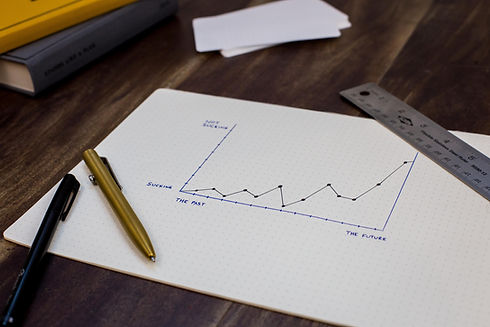Emergency Funds in a TFSA: 3 Ideas to Consider
- Jorge Diaz
- Dec 4, 2019
- 7 min read
Updated: Apr 22, 2021
As an entrepreneur, you must learn how to manage money. While you are starting as an entrepreneur, while your business grows or when you head into retirement, your wealth reserves will be the most critical element of personal financial success. On the downside, if your business is not actually generating money, the same skill will help you stay afloat while focused on your mission of making things work.
So, the same way you should prepare to start the business (funds, ideas, planning...), you should also be prepared to keep it alive at the best and the worst possible scenarios, when it comes to financials.
This specific will not focus on the actual business money operations. I will write about that in future articles. I will focus now on the Finance side of the entrepreneurship himself/herself. I will talk about three main things to consider during the first stages of a startup in order to continue building your project make you work all the way: inflation, emergency funds & TFSA.
#1 The Inflation Factor
Inflation occurs every second we live, although it is measured mainly year after year. On the Bank of Canada website, there is a Calculator that allows you to calculate how much money "depreciates" in Canada. The tool includes all historical data from 1914 to today. Indeed, more than 100 years.
To give you an idea, the average inflation of the Canadian dollar in the past five years has been about 1.8%. This means that if you store your money right as it is, it will lose value over time. You put it on a 2% return savings account, and you will be mostly avoiding that it devaluates.

You can calculate how much the Canadian currency value has inflated since 1914. During the past 5 years, the United States Dollar inflation has been relatively similar to the Canadian Dollar One: about 1.8% per year.
No matter what, it will be crucial you keep inflation in mind. It affects everyone, no matter where, and this is one of the main reasons why you should do something with your money — both your savings and what comes to be the main topic of this article: your emergency fund.
#2 Ideal Emergency Fund Size
An emergency fund (EF) is a cash ("availability") reserve that allows you to face different challenging situations that might come up during the initial stage of your business. Please note that with the "initial stage" I mean either the first weeks up to a couple of years or more, of a "startup" stage. And I'm not saying that your business may not be generating money. In fact, it might be making a lot of profits, maybe more than you expected, but that doesn't mean you not need to know how to handle it right before it comes into your hands.
Although this article is specific for Entrepreneurs, an EF is a good idea for everyone, not just business owners. You never know what may come up in life, so better be prepared.
As I mentioned before, the most important part is that your reserve is accessible. If you suddenly need cash, you should be able to get it instantly. The availability of this cash will be the source of resources that will allow you to pay all your bills while you continue operating your business under "emergency" situations.
How Big Should It Be?
I would say between 2 and 4 months of expenses as reserves for the initial stage of your startup and between 1 and 2 months once your business is generating profits. If your business model is seasonal, having a larger one may also be a good idea. Still, on a future article I will refer more specifically to the "transition" process from your full-time job to Entrepreneur, but let's assume you did your leap of faith at the right time, for now.
An example: assume your household expenses are about ~$4,000 per month. I would estimate that you need, at least between 8K and 16K available, although probably only 4K instantly available. The remaining amount can be placed in a different place, but at least a couple of business days away from being ready to be used. (I'll talk about this further in this article).
This example previously mentioned will be repeatedly used in the following section to describe the possible scenarios of asset allocations for the Emergency Fund.
If you live with a partner that contributes to house expenses, then add it into the account too. In the same way, both of you contribute, you should consider the risks of your partner suddenly losing his/her job.
#3 The Right Place
Without going too deep into the RRSP/TFSA comparison, as it is a topic big enough to discuss in multiple articles, the ideal account for emergency funds is a TFSA one (assuming you still have allowance available).
If you want to learn more about RRSP and TFSA accounts, I encourage you to read Gordon Pape's books about it.
If you don't have an available room or prefer not to use your TFSA accounts for it, just proceed with a regular savings/investing account according to the mentioned alternatives in this section:
Alternative 1: Savings Account (low risk)
Alternative 2: Savings Account & TFSA Fund (mid risk)
Alternative 3: Line of Credit & TFSA Fund (high risk)
IMPORTANT SIDE NOTE: Always discuss the following with a financial advisor.
Alternative 1: Savings Account (low risk)
The easiest way to build an EF is by storing the funds in a Savings Account. If you were to have the $12,000 (three months of savings) from the previous example in a registered TFSA account, you need to consider the 1,8% yearly inflation and then, the availability of the fund.
Regular savings accounts allow immediate withdraw of the funds. You would be then placing 100% of the funds on that account and be withdrawing these only under emergency situations.
Please, always remember that any TFSA withdrawal opens new allowance space in the next natural year where the funds were taken out. If you take out $4,000 (one month of expenses) on June 22nd, the room will be available again by January 1st of the next year.
Managing Inflation
Saving accounts are not "great," but mostly take care of covering most of the inflation. Depending on the bank, the account type, and the amount of money deposited, you can get rates that go from 0.5 to 2.3%. This translates literally that your money is safe, these funds are covered by the CDIC for up to $100,000, and it will never go down.

On average, Savings Accounts on most Canadian banks offer a yearly interest rate of return slightly above inflation. You can compare Saving account rates at Ratehub.ca Banking Products.
Alternative 2: Savings Account & TFSA Fund (mid risk)
This second alternative is partial. Part of your money is on a Savings Account (SA) and the other one on an investment Fund. Investment Funds regularly have fund availability between 3 and 10 business days, so these are not immediately ready as a regular SA.
On this specific scenario, our sample case could split the EF into two parts:
Savings Account: 33% of the funds (1 month) $4,000 at an average (2.0% yearly return)
TFSA Investment Fund: 66% of the funds (1 month) $8,000 at an average 8.0% yearly return (to mention an example)
Why Risking part of your Emergency Fund?
It may sound contradictory to invest part of your Emergency Funds into the stock market (to mention an example) but consider the following:
Do you have an EF right now? Statistics Canada reported that "Average net saving for all Canadian households was $852 in 2018". This means that most people don't have an available source of cash for an emergency situation. It is vital to set up your mind towards a specific objective and work towards achieving it. Even if you go straight to option #1 after reading this, it would have been more than successfully for me to achieve waking up your interest in building an EF.
If you have one, you need to consider Inflation rates. Either if you have a pile of cash under your bed or lots of money in the bank, you need to embrace the fact that inflation and compound interest can work either for or against you. Although I would never suggest anyone run out of availability, it is always good to understand how to deal with an emergency and think in the long run.
How about if nothing ever happens? Have you ever considered if simply nothing happens to you? Do you have an idea how much return you can get from, let's say, $8,000 compounding at 8% yearly after 30 years? Your EF would grow up to $80,501.26. You can do the math on this Compound Interest calculator tool I use every day.
You need all the motivation you need. Last but not least: You will go the extra mile to make things work and not risk your EF. You will call that additional client; you will make that extra hour you know will reward you. You will make it work as you know all the benefits that come with the fact you are pushing forward a specific direction.
Alternative 3: Line of Credit & TFSA Fund (high risk)
And this is the third and riskier approach, but the most rewarding one — a combination between a Line of Credit and a TFSA investment Fund.
Back again to the sample case, the resource distribution for the EF could go as follows:
Line of Credit Availability: 0% of the funds with a limit of $8,000.
TFSA Investment Fund: 100% of the funds $12,000 at an average 8.0% yearly return (same case as before)
The key difference here is that all your emergency fund is invested while a Line of Credit (LoC) provides you with the cash availability on emergencies. Essentially, your EF net worth is $12,000 on day 1, but the fund allocation is entirely invested.
How does it compare to Alternative #2? Well, first, if you withdraw money from the LoC, you will have to start paying interest. It if somehow you anticipate a big event is on the way, you may want to have an approach that combines this variant with Alternative #2 and have a Savings Account for it. On the other hand, your fund can potentially grow (at an 8% rate for 30 years) up to $120,751.88.
Where Canadian Entrepreneurs can Put their Funds
I will leave that for another day :) I think so far it has been more than enough content to think about it ;)
New To Investing?
If you are in Canada and are looking for ways to grow your wealth, you should start by opening an account at Questrade Inc. and begin investing your money. It is the #1, most prestigious and most affordable brokerage in Canada. By following this link, you will get a cash bonus, up to $250, depending on the amount you deposit when you open/transfer your TFSA, RRSP, RESP or brokerage account.




Looking for a reliable web development company in Ontario? Get expert solutions to boost your online presence and grow your business efficiently!